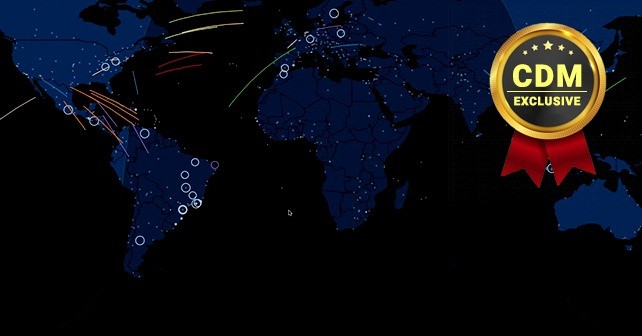By Imad Mouline, Chief Technology Officer, Everbridge
Global threats have increased in complexity and unpredictability. The critical events we face today are more frequent and unfortunately, costlier and potentially life-threatening, creating a challenge for outdated emergency and IT incident communication systems and processes. From sophisticated cyber attacks to all-too-frequent incidents involving workplace violence or terrorist attacks, security managers’ traditional perception of global security has undergone a necessary change.
The problem? Many large organizations maintain multiple, separate Emergency, Security, IT and Supply Chain Command Centers which not only each requires 24×7 availability, but utilize siloed tools and processes, making it difficult to create a unified view of the threat assessment and resolution process. In this scenario, individual departments do their own assessment of threats, and often times come to different conclusions of their severity, causing break downs in communications, poor visibility and an increase in the cost of disruption. Without a unified view, an organization’s response to threats can be delayed and incorrect, leaving its employees, facilities, travelers, systems and other critical assets vulnerable.
Another issue with maintaining separate command centers is that today’s security managers need more than an employee’s static office or home address. Security managers need visibility into all mobile, remote and traveling employees’ locations at all times, especially resolvers who can triage incidents, should a critical event occur. With 72% of workers projected to be mobile by 2020 and spending significant time away from a traditional office facility, locating workers, sharing critical information and directives and communicating with decision-makers and response teams becomes an even more complicated task.
Therefore, it’s important for today’s organizations to combine communication systems, incident management systems and threat visualization tools into one centralized critical event management process. When an organization integrates physical and digital tools, they achieve an end-to-end view integrating threats, operational impact and response status information on a “single pane of glass.” This unified event management view provides the ability to better assess what is happening at a given moment across offices, campuses, supply routes, systems and even near traveling employees. This single platform combines employee safety capabilities with threat assessment and visualization capabilities, allowing the organization to effectively manage the full array of intelligence, and therefore assess, locate, automate, communicate, and manage today’s complex threats that impact security, safety, IT, supply chain and business operations.
In addition, a centralized critical event management process and system allows for dynamic location tracking and alerting of impacted personnel, response team members and key stakeholders such as the Board of Directors, should an emergency occur. Whether in the air, in the field, or at the office, organizations can find their employees by integrating their system with location-based technologies such as access control systems, Wi-Fi networks, travel management solutions, and mobile panic button applications.
This is especially important during an active shooter situation, for example. If an active shooter was reported on an organization’s campus, it’s important for the organization to send the correct information to all its affected people, based on their location. If the active shooter was reported on the east section of the campus, the targeted alert would want to tell employees and staff on the east section of campus to shelter in place, while the alert may want to tell employees on the west section of campus to get off the property. Alternatively, it would be important for the organization to inform visitors and employees who were expected to be on the campus later that day to stay away until police secure the area.
When managing this type of crisis, whether operational or emergency in nature, it’s important for an organization to have the ability to easily identifying who can help, and how. Leveraging an integrated critical event management system in which all information is centrally located allows organizations to initiate instant communications that share relevant information and status updates with not only key stakeholders but emergency responders as well. When first responders have better, more accurate information about who needs help and who’s safe they’re able to take more direct, focused action that can help save lives and quickly end a situation. There’s no confusion as to who should send out the communications, and no one is waiting on important information that is essential to convey – everything is streamlined and pre-determined, which is vital when every second count.
The bottom line? The way current critical communications and incident management processes are set up within organizations is inefficient, ineffective and – most importantly – can severely impact employee safety and business operations. But, managing critical events can be like any other major business function with a centralized crisis communications center and a consolidated critical event management system—a process with clear lines of responsibility, common situational understanding, accountability and visibility of performance. By removing the hassle and confusion of overlapping tools and departments, organizations can create a single, unified view of the threat assessment and resolution processes to keeping the organization safe and productive during whatever incident may come it’s away.
About the Author
 Imad Mouline is the Chief Technology Officer Everbridge. He is responsible for market strategy, product roadmaps, and R&D. Mouline joined Everbridge in 2011 when the company acquired CloudFloor, where he was co-founder and CTO. Previously, Mouline served as CTO in the web performance and financial services industries. Mouline graduated from MIT, and holds four U.S. patents. Imad can be reached at @ImadMouline and at our company website http://www.everbridge.com/.
Imad Mouline is the Chief Technology Officer Everbridge. He is responsible for market strategy, product roadmaps, and R&D. Mouline joined Everbridge in 2011 when the company acquired CloudFloor, where he was co-founder and CTO. Previously, Mouline served as CTO in the web performance and financial services industries. Mouline graduated from MIT, and holds four U.S. patents. Imad can be reached at @ImadMouline and at our company website http://www.everbridge.com/.


